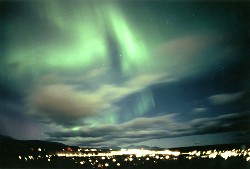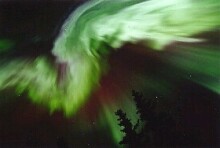Auroras
Page Two
Because the earth's magnetic field lines are concentrated near the north and south magnetic poles, that's where the auroras are most likely to occur. They are most dramatic when there is a lot of solar activity, as explained on the previous page.
Can you photograph an aurora? You probably can, if you have access to a 35mm single lens reflex camera with a 50mm lens that will allow you to focus, change the aperture size, and to set the shutter speed. Fully automatic tiny 35mm cameras that are now popular often won't let you do any of these things, and so won't capture a picture of an aurora.
The problem is that, while an aurora looks magnificent to the eye, there really isn't a lot of light available to create an exposure. The shutter will have to be left open anywhere from 15 to 60 seconds. Try an ISO setting of 1600, and use a tripod. You also should have a cable release to trigger the shutter remotely, so you won't jiggle the camera as you open and release the shutter.
|
|
Aurora Borealis over Alaska [Takasaka]
|
|
|
|
Because the shutter will be open for 15-60 seconds instead of the usual tiny fraction of a second, any movement of the camera will blur your picture and ruin it. Similarly, if the aurora is very active, the moving curtains of light will also make your photo blurry. The best images occur when the aurora is reasonably steady.
If your camera has an autofocus setting, turn it off, and manually focus to infinity. In fact, turn off all other automatic features as well.
Open your camera's aperture as wide as it will go. The smaller the f/stop you can get, the better. (f/2.8 or wider is recommended). Set the shutter speed to 'always open', and manually time how long it stays open after you press the release.
|
Experiment with different times, and take a variety of shots.
Actual times and settings will depend on the type of camera, the size of your lens, and the aperture settings available on the camera.
If you're lucky, you should be able to capture an image of an aurora, perhaps even a great image. You'll also capture a few stars, and perhaps a satellite or two moving across the sky (this will appear on the photo as a short white streak).
I have no direct experience with photographing auroras, although I've taken a lot of pictures of stars and planets, and the moon.
Page 1 | Main Page
|

